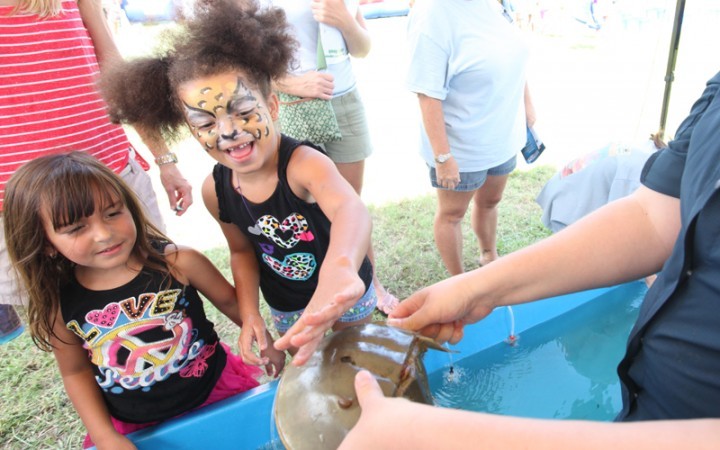
INDIAN RIVER COUNTY — Florida’s ecosystem took center stage Saturday, in simultaneous National Estuaries Day Celebrations at both the Harbor Branch Oceanographic Institute at FAU and the Smithsonian Marine Ecosystems Exhibit at the St. Lucie County Aquarium.
Science came to life for young and old alike, as marine biologists and volunteers at the two eco-centric organizations introduced families to a myriad of creatures and plant-life that call countless underwater habitats home.
Children gazed at the unique living displays at the Aquarium with an almost reverent hush, seemingly not wanting to disturb the colorful fish swimming in the exhibits.
The six displays represent the sea grass, mangrove and lagoon hard-bottom ecosystem habitats of the Indian River Lagoon, and the coral, near-shore and Oculina reef ecosystem habitats of the Florida Coastal Ocean. The dark-as-night Oculina exhibit featured creatures living in the deep-water reef, a unique habitat found only off the Treasure Coast.
“All of the coral in our exhibits are still living,” said marine biology educator Chelle King, noting that the coral reef display was previously housed at the Smithsonian in Washington, DC and is approximately 30 years old.
“We’ve had people call us the best kept secret,” said Cristen Ryan, who co-chaired the Smithsonian celebration with Laura Diederick, adding that many residents are just beginning to realize what they offer.
The facility changed its name last year from St. Lucie County Marine Center to St. Lucie County Aquarium which she said, “Clarifies what they’ll see when they come down here.”
The Smithsonian festival included 38 exhibitors, from local environmentalist groups and government agencies to other nonprofit organizations, but for the younger set, the one-on-one time with critters was the best part.
“Awesome!” said 5-year-old Kayden as he gently cradled a sea hare in the palm of his hand. “I’ve never holded (sic) one of these before!”
Still other dexterous kids were using their video game skills to operate a remote operated vessel (ROV), trying to manipulate it around a kiddie pool to “capture” a plastic lobster.
At Harbor Branch, where the celebration was co-chaired by Cindy Wilson and Jim Masterson, a host of other fun and educational activities awaited.
Hourly presentations by HBOI and FAU scientists gave overviews on oysters, various Indian River Lagoon species, dolphins, mangroves and sea grass.
Bryan Chauncey entertained the little ones with two Caribbean themed performances of “The Journey of Choncey Conch,” and out on the lawn kids frolicked on bounce houses and inflatables.
An oyster restoration mat fabrication exploration station, a new activity this year organized by Dr. John Scarpa, seemed to draw a slightly more mature crowd.
Visitors meticulously tied 36 oyster shells to uniformly sized plastic mats, which will be placed in the northern part of the Indian River County Lagoon system.
“This really will be used for science,” assured Scarpa, who would later be tasked with verifying that each shell was securely fastened.
Although their National Estuaries Day Celebration was scaled back slightly from last year, Larry Macke, HBOI research technical writer said, “There is a real desire and intent to get the community out here more often.”
“The Indian River Lagoon is such a precious resource and is one of the primary focuses of our research here at Harbor Branch,” added Cara Perry, HBOI director of external relations.
“Smithsonian and Harbor Branch have a rich history. We want to continue to come together to celebrate National Estuaries Day with events such as these.”



